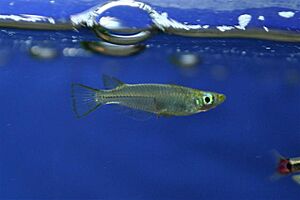Chinese rice fish facts for kids
Quick facts for kids Chinese rice fish |
|
|---|---|
 |
|
| Conservation status | |
| Scientific classification | |
| Synonyms | |
|
The Chinese rice fish (Oryzias sinensis) is a small freshwater fish. It lives in places like swamps, slow-moving parts of streams, and especially rice fields. This fish is quite tiny, growing up to about 3.1 centimeters (1.2 inches) long.
For a long time, people thought the Chinese rice fish was just a type of Japanese rice fish. But now we know it's its own unique species! You can find these fish naturally across East Asia and Southeast Asia. This includes big river systems like the Yangtze and Mekong. They have also been accidentally or purposefully moved to new places, like Kazakhstan and parts of Russia.
Contents
How Chinese Rice Fish Help Farmers
Chinese rice fish have been important in China and other parts of Asia for hundreds of years. Farmers use them in rice farming. This is a special way of farming where the fish live in the rice fields.
The fish help the rice plants grow better. They add nutrients to the water, which acts like a natural fertilizer for the rice. Because of this, rice fields with these fish can produce 4% to 15% more rice!
What Do They Eat?
Chinese rice fish are omnivores, meaning they eat both plants and animals. Their diet includes tiny plants, microscopic creatures like zooplankton and algae, and even parts of insects.
This eating habit makes them very useful in rice fields. They help control pests by eating insect larvae. This means fewer harmful insects for the rice plants.
Where Do They Live?
These fish love shallow, slow-moving freshwater. They especially like areas near shorelines that have lots of plants. Rice paddies, ponds, and farming channels are perfect homes for them.
When the water gets cold, Chinese rice fish can go into a state similar to hibernation. This helps them survive the colder months.
Who Eats Them?
In the wild, Chinese rice fish are often eaten by other animals. Their main predators include dragonfly larvae, bigger fish, and birds. Most Chinese rice fish live for about one year in the wild. But if they are kept in aquariums, they can live much longer, sometimes four years or more!
When They Become Invasive
Sometimes, Chinese rice fish can become an invasive species. This means they spread to new areas where they don't naturally belong. When this happens, they can sometimes cause problems for the local ecosystem.
For example, they were accidentally introduced to the Yarlung Tsangpo River. Their small size helped them survive and reproduce easily in this new environment. This shows how adaptable they are to different places. Scientists also think that warming waters from global warming might help these fish spread even more. This is because they prefer warmer temperatures for having babies.
Why They Are Used in Research
Chinese rice fish are known as "model organisms" in science. This means they are very useful for scientists to study. They are easy to keep because they don't need special food or a complicated habitat.
They also have short "generation times," meaning they grow up and have babies quickly. Their eggs are also clear, which makes it easy for scientists to watch them develop. All these features make them great for studying how animals grow and how they are affected by their environment.
Images for kids



